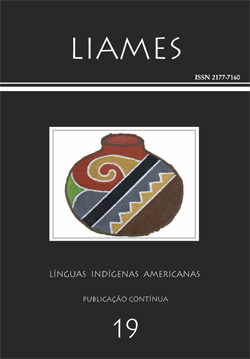Abstract
This article describes and substantiates the orthography of the Awetí language (Tupí, Alto Xingu/ mt), based on the analysis of the phonological and grammatical structure of Awetí. The orthography is a result of a long collaborative effort of the three authors, started in 1998. It establishes more than an alphabet (the representation of the vowels and consonants of the language): it also deals with internal variation, re-syllabification, lenition, and other (morpho‑)phonological processes. Special attention was given to the written representation of the glottal stop, as well as the orthographical consequences of nasal harmony. Although the lexical accent (stress) is not explicitly marked in Awetí, most of its affixes and particles is examined as to their stress and interaction with neighboring morphemes, also determining orthographical words. Finally, the alphabetical sort order is established, where digraphs are treated as regular sequences of letters, and the glottal stop ⟨ʼ⟩ is ignored, what helps learners of Awetí (writing). The orthography as described here has now been used for some 10 years in the village school for alphabetizing in Awetí, with good results. We believe that several of the arguments raised here can be fruitfully transferred to other languages with similar phenomena (glottal stop as consonant, nasal harmony, morpho-phonological assimilation, etc.).
References
D'Angelis, Wilmar da Rocha (1994). Conquistar ou construir a escrita? A definição de uma ortografia no Ashaninka do Rio Amônia. Leitura, Teoria & Prática 24: 3–19.
Drude, Sebastian (2002). Fala masculina e feminina em Awetí. In: Ana Suelly A. C. Cabral; Aryon Dall’Igna Rodrigues (eds.). Línguas indígenas brasileiras: Fonologia, gramática e história. Atas do I Encontro Internacional do Grupo de Trabalho sobre Línguas Indígenas da ANPOLL, tomo 1, pp. 177-190. Belém: Editora UFPA . Versão em PDF. Disponível em:
https://pure.mpg.de/rest/items/item_1466293/component/file_1466406/content. Acesso em: 19 jun. 2019.
Drude, Sebastian; Sabine Reiter & Hans-Heinrich Lieb (2006). A documentation of the Awetí language and aspects of their culture [Multimedia Language Archive]. Com contribuição de Waranaku Aweti, Awajatu Awetí, Yakumin Aweti, Tawyjat Aweti, Parawajru Aweti, Xiaoqin Su, Eva-Maria Roessler, e outros. Nimegue, Países Baixos: Max-Planck-Institute for Psycholinguistics. DOBES-Programme / VolkswagenStiftung. Disponível em: http://hdl.handle.net/hdl:1839/00-0000-0000-0001-305C-A. Acesso em: 19 jun. 2019.
Drude, Sebastian. (2009). Nasal harmony in Awetí – A declarative account. ReVEL – Revista Virtual de Estudos Da Linguagem 3. Disponível em: http://www.revel.inf.br/files/artigos/revel_special_3_nasal_harmony_in_aweti.pdf. Acesso em: 18 jun. 2019.
Drude, Sebastian (2011). Word accent and its manifestation in Awetí. In: Francesc Queixalós; Leo Wetzels (eds.). Amerindia 35: 189–218. (Edição especial ‘Estrutura das línguas Amazônicas’). Disponível em: http://www.vjf.cnrs.fr/sedyl/amerindia/articles/pdf/A_35_02.pdf. Acesso em: 18 jun. 2019.
Drude, Sebastian (em preparação). A fonologia da língua Awetí.
Eisenberg, Peter (1983). Orthographie und Schriftsystem. In Klaus B. Günther; Hartmut Günther (eds.). Schrift, Schreiben, Schriftlichkeit, pp. 41–68. Tübingen: Niemeyer (Germanistische Linguistik
.
Emmerich, Charlotte; Monserrat, Ruth M. F. (1972). Sobre a fonologia da língua Aweti (Tupi). Boletim do Museu Nacional N.S. Antropologia 25: 1–18.
Figueiredo, Marina Vanzolini (2009). Escrever, ouvir: perspectivas sobre o saber entre os Aweti do Alto Xingu. Ide 32/48: 147–162. São Paulo. Disponível em: http://pepsic.bvsalud.org/pdf/ide/v32n48/v32n48a17.pdf. Acesso em: 19 jun. 2019.
Franchetto, Bruna (2008). A guerra dos alfabetos: Os povos indígenas na fronteira entre o oral e o escrito. MANA: Estudos de Antropologia Social 14(1): 31–59. Rio de Janeiro: PPGAS/ Museu Nacional. Disponível em: http://www.scielo.br/pdf/mana/v14n1/a02v14n1.pdf. Acesso em: 19 jun. 2019.
Fuhrhop, Nana (2005). Orthografie. (Kurze Einführungen in die germanistische Linguistik 1). Heidelberg: Winter.
Meira, Sérgio (2004). O linguista e a ortografia indígena: O caso da língua Bakairi. Revista de Estudos e Pesquisas 1(2): 73–99. Disponível em: http://www.funai.gov.br/arquivos/conteudo/cogedi/pdf/Revista-Estudos-e-Pesquisas/revista_estudos_pesquisas_v1_n2/Artigo-3-Sergio-Meira.pdf. Acesso em: 19 jun. 2019.
Monserrat, Ruth M. F. (1976). Notas sobre a morfofonêmica Aweti. Rio de Janeiro. (Manuscrito para
apresentação oral.)
Monserrat, Ruth M. F. (1992). Proposta de um alfabeto para a língua Aweti (Manuscrito.)
Postigo, Adriana Viana (2014). Língua Wauja (Arawák): uma descrição fonológica e morfossintática (Tese de doutorado). Araraquara: Universidade Estadual Paulista “Júlio de Mesquita Filho”. Disponível em: http://www.etnolinguistica.org/tese:postigo-2014. Acesso em: 19 jun. 2019.
Rodrigues, Aryon Dall’Igna (1999). Tupí. In: Robert M. W. Dixon; Alexandra Y. Aikhenvald (eds.). The Amazonian languages, pp. 107–124. Cambridge: Cambridge University Press.
Rodrigues, Aryon Dall’Igna; Cabral, Ana Suelly Arruda Câmara (2012). Tupían. In: Lyle R. Campbell; Verónica María Grondona (eds.). The indigenous languages of South America: a comprehensive guide. pp. 495–547. Berlin, Boston: De Gruyter Mouton.
Troncarelli, Maria Christina; Drude, Sebastian; Würker, Estella (eds.) (2002). Awytyza Ti'ingku. Livro para alfabetização na língua Awetí. São Paulo: Instituto Socioambiental.
The LIAMES: Línguas Indígenas Americanas uses the Creative Commons license (CC), thus preserving the integrity of the articles in an open access environment.



